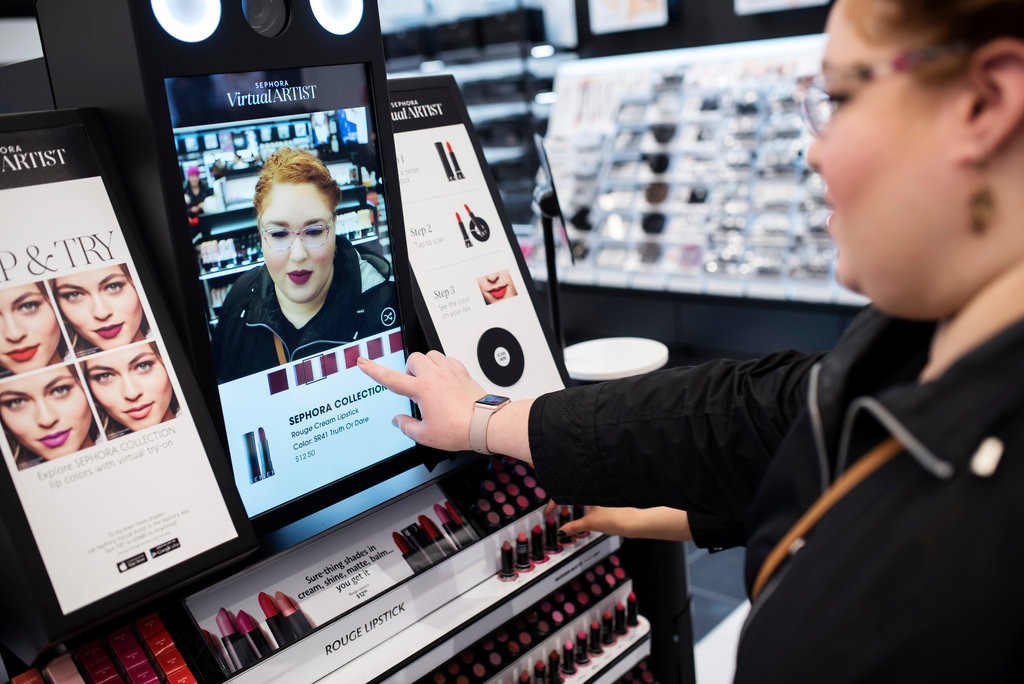While first beauty tools focused on solely product innovation, such as Clarisonic with its single purpose of a pulsing face brush to cleanse your face, newer technologies powered through AI and Augmented Reality can create new solutions that tailor customer demand. Nowadays technology is becoming increasingly paired with beauty and cosmetics. Companies are continuously looking for novel ways to drive innovation in a saturated cosmetics industry. Digital transformation can not only create digital in-store experiences and build a customer relationship but also empower customers by letting them try on make up whenever and wherever they want through digital devices (Draper, 2018).
From digital merchandise to a seamless customer journey
Augmented reality can be used to overlay digital images into the real world (Dudkin, 2019). ModiFace, a provider of AR technology, uses facial recognition and augmented reality to apply makeup and other cosmetic products on people’s faces through digital devices. Customers can view themselves with the make-up look applied and hence are provided tools to make a better purchasing decision. World-leading and renowned leader in beauty and cosmetics, Sephora, picked up on this trend and introduced Sephora’s Virtual Artist as a new way of shopping, improving customer experience significantly (Thomas, 2019).
As a result, customers interact with brands online and through these devices and build a connection with the brand. It adopts a bidirectional effect where not only customer experience is improved but simultaneously collecting consumer data about their (product) preferences and features. Furthermore, data capturing can lead to personalized product recommendation and optimal product personalization. PerfectCorp. announced YouCam Beauty 3.0, an AI-based augmented reality tool that recommends customers makeup against a high rate of accuracy and realism based on what will personally suit you. This mobile app increased customers’ basket sizes, led to higher conversion and overall reduced the number of returned products (Shu, 2019).
The Future of make-up
It is predicted that the future of beauty will focus on both online and offline experiences such as virtual try-on apps, skin diagnostics and smart mirrors powered through voice. This allows for efficient data collection about customer preferences and hence can be deployed targeted advertising. It also captures data about customer skin, portray how customers interact with make-up and can anticipate market trends (Avvocato, 2019).
In January this year, Procter & Gamble (P&G) announced a novel beauty product, the Opté wand, a make-up printer. The wand can scan the skin and apply delicate amounts of make-up to hide spots and other blemishes. The tiny built-in camera in combination with a microprocessor that analyses data to differentiate between different colors of skin. A micro-printer will then apply the foundation to your skin. P&G has the ambition to launch the product by 2020, after testing it for utmost precision (Thomas, 2019). Another disruptive change in the beauty industry is led by design agency, Seymour Powell with its intelligent make-up printer ‘Élever’. Make-up as seen online could be directly printed on your face through the use of 3D-printing, facial recognition technology and AI-powered image analysis technologies.
Avvocato, L. (2019). The Power of Artificial Intelligence for Cosmetics Brands. [online]. Retrieved from:
https://www.launchmetrics.com/resources/blog/artificial-intelligence-beauty-industry
Draper, S. (2018). L’Oréal Trying Augmented Reality to Bring the Makeup Counter Into Your Home. [online]. Retrieved from:
https://www.wearable-technologies.com/2018/06/loreal-trying-augmented-reality-to-bring-the-makeup-counter-into-your-home/
Dudkin, I. (2019). Benefits of Augmented Reality for the Beauty Industry. [online]. Retrieved from:
https://skywell.software/blog/benefits-of-augmented-reality-for-the-beauty-industry/
Shu, C. (2019). The company behind YouCam Makeup app launches a new set of AR tools for beauty brands like Ulta. [online]. Retrieved from:
https://techcrunch.com/2019/01/10/the-company-behind-youcam-makeup-app-launches-a-new-set-of-ar-tools-for-beauty-brands-like-ulta/
Thomas, D. (2019). Five tech trends shaping the beauty industry. [online]. Retrieved from:
https://www.bbc.com/news/business-48369970


